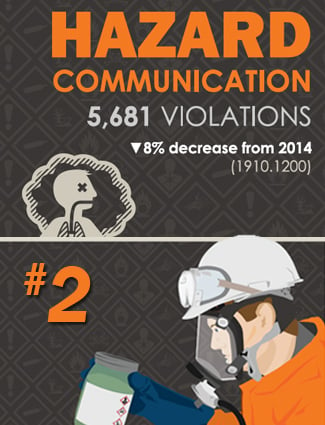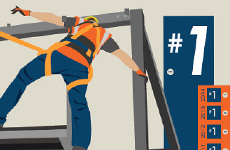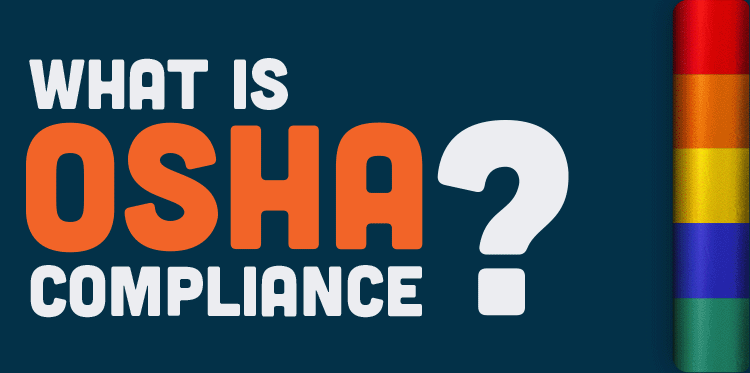OSHA Citations
03
February,
2023
4 MINUTE READ

OSHA citations are routinely given to companies throughout the United States. Organizations large and small routinely face citations for hazards that may harm workers, and the abatement process can be arduous and confusing.
This article breaks down OSHA citations, common violations, potential penalties, and the courses of action an employer may take after receiving a citation.
What is an OSHA Citation?
A compliance officer may inspect a workplace as part of a routine inspection, or following a complaint about hazardous conditions. Following the inspection, an OSHA area director reviews the findings and determines what, if any, citations will be issued.
OSHA then issues a citation that informs the employer of any regulations and standards they may have violated, along with proposed penalties. The employer must post a copy of each OSHA citation at or near the place where a violation occurred for three days or until the violation is abated, whichever is longer.
OSHA citations are not issued as a penalty for an injury or fatality. They are issued to address violations of OSHA standards and for safety hazards identified by the OSHA compliance officer.
Most Common OSHA Citations

The same 10 offenses have shown up on OSHA's annual list of the most common violations every year between 2011 and 2015. Those violations were, in 2015:
- Fall Protection (29 CFR 1926.501)
- Hazard Communication (29 CFR 1910.1200)
- Scaffolding (29 CFR 1926.451)
- Respiratory Protection (29 CFR 1910.134)
- Lockout/Tagout (29 CFR 1910.147)
- Powered Industrial Trucks (29 CFR 1910.178)
- Ladders (29 CFR 1926.1053)
- Electrical?Wiring Methods (29 CFR 1910.305)
- Machine Guarding (29 CFR 1910.212)
- Electrical?General Requirements (29 CFR 1910.303)
Interested in learning more about these violations?
Duralabel produces an infographic that breaks down the 10 most common OSHA violations each year. It outlines the top violations, covers trends, and provides resources for staying safe on the job.
OSHA Citations: Proposed Penalties
OSHA increased maximum penalties in August 2016 for the first time in 25 years. The new penalties, which followed a directive from Congress that required federal agencies (such as OSHA) to adjust civil money penalties based on inflation, led to a 78% rise in potential penalties.
Penalties may vary, depending on the type of citation given by OSHA. Here are the types of citations, along with the penalties that may be proposed.
Willful Violation
Overview: A "willful" violation occurs when the employer knowingly commits a violation, or when a violation is committed with indifference to the law. The employer either knows what they are doing is a violation of OSHA standards, or they are aware a hazardous condition existed and made no reasonable effort to eliminate that hazardous condition.
Potential penalties: There is a maximum of $124,709 for a willful violation. A proposed penalty may be adjusted downward, depending on the size of the business and its history of previous violations. No credit is given for good faith efforts when weighing possible penalties. If an employer is convicted of a willful violation that resulted in the death of an employee, the offense is punishable by a court-imposed fine, imprisonment for up to six months, or both.
Serious Violation
Overview: An employer may be cited for a "serious" violation when the hazard could likely result in death or serious physical harm, and the employer knew about or should have known about the hazard.
Potential penalties: A mandatory penalty of up to $12,471 for each violation can be proposed. This may be adjusted downward, based on the employer's good faith efforts to comply with OSHA standards, their history of previous violations, the gravity of the alleged violation, and the size of the business.
Other Than Serious Violation
Overview: A citation for an "other than serious" violation is issued when death or serious injury wouldn't have occurred due to a particular safety hazard.
Potential penalties: A penalty of up to $12,471 for each violation may be proposed. This penalty may be adjusted downward by as much as 95 percent, depending on the employer's good faith efforts to comply with OSHA standards, their history of previous violations, and the size of business.
Repeated Violation
Overview: Employers may be cited for a "repeated" violation when they have previously been cited for the same (or a similar) violation and the earlier citation(s) have been finalized. If an employer is currently contesting a citation, that violation may not serve as the basis for a "repeated" violation.
Potential penalties: A fine of up to $124,709 for each such violation may be proposed.
Failure to Abate Prior Violation
Overview and potential penalties: Failure to abate a prior violation may bring a civil penalty of up to $12,471 for each day the violation continues beyond the specified abatement date.
De Minimis Violation
Overview: A de minimis violation occurs when the violation has no direct or immediate relationship to safety or health. Whenever de minimis conditions are found during an inspection, they are documented with other violations, but they are not included as a part of the OSHA citation.
Responding to an OSHA Citation
OSHA must issue any citations within six months of the alleged violation. When an employer receives a citation, they may choose one of these three responses:
- Formally contest the violation: Employers have 15 business days after receiving a citation to contest the violations or penalties. At that point, the Occupational Safety and Health Review Commission is called upon to independently review the appeal.
- Appeal the citation: When an employer elects to appeal a citation, OSHA sets up an informal conference with the OSHA Area Director to discuss the violations, penalties, citations, and other relevant details. All involved parties may work to reach a settlement agreement-in which penalties may be reduced and the seriousness of the violation downgraded-if the violations have been resolved.
- Pay the fine: An employer may also choose to pay all applicable fines in full, without an appeal or contest.
If an employer receives a violation, OSHA will provide instructions for each of the three potential responses.
OSHA Citation Solutions
Employers, employees, and OSHA investigators can all agree: The best way to avoid citations is to comply with OSHA standards. Duralabel offers numerous resources for helping employers establish safe workplaces.
- Duralabel produced a guide analyzing the Top Ten OSHA Violations. The guide looks at historical data, provides insight into OSHA standards, and provides tips and resources for improving workplace safety.
- Safety signage can alert employees to hazards, advise them of proper precautions, and promote safe behavior throughout a facility. Learn more about meeting OSHA requirements for safety signage.
- DuraLabel industrial label and sign printers by Duralabel can help employers create custom signs that comply with OSHA standards and meet needs unique to each facility. Learn about the top 10 uses for DuraLabel printers, and see which printer may be right for you.
RELATED RESOURCES

What is OSHA Compliance?
Dangerous working conditions nationwide sparked the creation of the Occupational Safety and Health Act (OSH ...
Read
OSHA 29 CFR 1926
Construction is a high hazard industry, with unique situations and hazards, and it employs more than six ...
Read
Scaffolding Fall Hazards
In November 2013, a Massachusetts roofer fell to his death while working on a condominium. An OSHA ...
Read.png)


